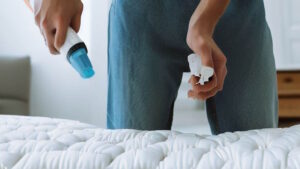Have you ever noticed a musty odor in your bedroom and found green and black patches on your mattress? If so, it’s likely that you’re dealing with mold.
Cleaning this off can be quite a daunting task, but don’t worry – we’ve got the How To Clean Mold Off Mattress tips to help you out!
In this Nousdecor article, learn how to spot mold on mattresses, prepare to clean it off, and prevent future mold from forming. Read on to find out how to tackle this challenge with ease!
Key Takeaways
- Regular airing and cleaning of air mattresses is important to prevent mold growth.
- Mold on mattresses can be caused by moisture trapped by mattress toppers or memory foam.
- It is crucial to promptly identify and address mold on mattresses, which can be identified by darker or discolored spots and a musty smell.
- Proper cleaning supplies such as vinegar, baking soda, and scrub brush should be used to clean mold off mattresses, and the mattress should be properly dried to prevent future mold growth.

What Causes Mold on Mattresses?
You may be wondering what causes mold to grow on your mattress. The truth is, there are many factors that contribute to the development of mold in mattresses.
An air mattress can easily become a breeding ground for mold spores if it’s not regularly aired out and cleaned. A mattress topper or memory foam can also trap moisture, creating an ideal environment for mold growth.
In addition, mold exposure from other sources such as a mattress protector, mattress pad, toxic mold, or any other type of mattress cover can cause the spread of spores and lead to increased levels of mold on your bedding.
With all these potential sources of contamination, it’s important to keep an eye out for signs of mold – and take steps towards cleaning it up quickly and effectively when found.
How to Spot Mold on Mattresses?
To identify mold on your mattress, look for spots that appear darker or discolored. Mold growth can be dangerous as it can cause allergies and asthma attacks. Black mold is the most common type of mold found on mattresses and other fabrics.
You may also notice a musty smell coming from your mattress, which indicates an infestation. To prevent further mold growth, consider taking preventive measures such as using dehumidifiers and increasing air circulation in the room.
If you suspect a mold problem, seek professional help with mold remediation for proper cleaning and removal. It’s important to take action fast to avoid any serious health risks associated with mold exposure like allergic reactions or asthma attacks.
Taking these steps will ensure your safety while preventing future issues caused by mold growth. With this knowledge in hand, you’re now ready to tackle the task of preparing to clean the mold off your mattress.
Preparing to Clean Mold on Mattresses
Before you can begin to clean the mold off of your mattress, it’s important to make sure that you have all the necessary cleaning supplies and that your mattress is ready for cleaning.
Gather gloves, a face mask, goggles, vinegar, baking soda, and a scrub brush so you’ll be protected and prepared as you tackle this task.
In preparation for cleaning the mattress, strip it down completely and put all bedding in the wash. Vacuum the entire surface of the mattress to remove any loose particles before tackling the mold with your cleaning solution.
Gathering Cleaning Supplies
Gathering the right cleaning supplies is essential for removing mold from a mattress. To help prevent mold and fungus growth, stock up on baking soda, foam cleaners, air purifiers, and stain removers. These items can be used together to cleanse your mattress of any moldy odors or stains that may cause skin irritation.
Additionally, make sure you have all of the necessary materials for proper mattress preparation before beginning the cleaning process.
With these items in hand, you’ll be well-equipped to tackle any molds lingering on your mattress and ensure a healthy sleeping environment.

Mattress Preparation
Before you begin the cleaning process, ensure that your mattress is properly prepared.
Start by removing it from the bed frame and airing it out in a well-ventilated area for a few hours.
Vacuum the surface of your mattress to remove any debris or dirt that could be harboring mold spores.
If your mattress has removable covers, take them off and wash them using hot water and detergent according to the manufacturer’s instructions.
After this step, you can start working on how to clean mold off mattress.
The key is to keep your mattress healthy while also knowing how to clean diarrhea from mattress, removing poop stains from mattress, maintaining mattress cleanliness after COVID, keep your pack ‘n play mattress clean, remove sweat stains from mattresses with our mattress sweat stain removal tips, and following a cleaning guide for purple mattresses.
With these tips in mind, you’ll be ready to tackle the job at hand!
How To Clean Mold Off Mattress
Cleaning mold off a mattress isn’t an easy job, but it can be done!
To start, you’ll need to expose the mattress to sunlight for a couple of hours.
Then use a vacuum cleaner to remove any remaining dust or dirt particles.
Next, disinfect the surface with cleaning solutions and wash the entire mattress.
After that’s done, let it dry thoroughly before you make your bed again.
With these simple steps, you should have no problem getting rid of mold on your mattress!
Expose the Mattress to sunlight
Expose your mattress to direct sunlight for at least an hour. Sunlight is a natural disinfectant and helps kill any lingering mold spores, as well as dust mites.
Here are some tips to ensure you get the most out of this step:
- Make sure the mattress is in a place where it won’t be disturbed – even slight movement can cause mold spores to spread further.
- If possible, move it outside on a clear day so that the light can reach all sides of the mattress.
- Turn your mattress over periodically throughout the exposure time to make sure all areas of it receive equal amounts of sunlight.
- Use this opportunity to inspect your care guide for your Newton Mattress and look for signs of damage or moisture buildup that may be causing issues with dust mite control for mattresses.
- Don’t forget to rotate it if you have a two-sided mattress! The sun’s rays will help keep both sides fresh and clean.
With proper exposure, you’ll soon be able to enjoy not only a cleaner but also a healthier sleeping space.
Transitioning into using a vacuum cleaner next!
Use a Vacuum Cleaner
After exposing the mattress to sunlight, grab your vacuum cleaner and start cleaning. Plug it in and make sure you’re using a hose attachment that can reach into crevices.
Slowly go over the entire mattress, making sure to get in any grooves or folds. If you see mold spores, give them an extra hard suction with the vacuum to pick up any remaining particles. As you move around, imagine each stroke is sucking away all of the mold spores so they won’t come back again.
Once you’ve finished vacuuming, move onto disinfecting with cleaning solutions for further protection against future infestations.
Disinfect with Cleaning Solutions
Cleaning mold off your mattress can be a difficult and tedious task. To make the job easier, you should arm yourself with baking soda, rubbing alcohol, and vinegar.
Baking soda is a natural cleaning agent that helps to absorb moisture and also deodorize the mattress.
Rubbing alcohol is an effective antifungal agent that can help to kill mold spores on contact.
Vinegar helps to break down the sticky residue of the mold and leave your mattress fresh and clean!
Baking Soda
Using baking soda is an effective way to clean mold off a mattress. It’s natural, non-toxic, and can absorb moisture and odors without harsh chemicals. Here are some tips for using it:
- Sprinkle a generous amount over the affected area.
- Let it sit for about 30 minutes.
- Vacuum up the baking soda with a brush attachment.
- Repeat if necessary until all mold is gone.
- Check the mattress periodically for further signs of mold growth.
Baking soda works wonders when it comes to removing mold and its musty smell.
Now, let’s consider another method: rubbing alcohol.

Rubbing Alcohol
Rubbing alcohol is another effective way to deal with mold, and it’s quick-drying.
| Step | How to Do |
|---|---|
| Lightly spray the mattress | with rubbing alcohol |
| Let sit for 15 minutes | ✔️ |
| Wipe down with a cloth | soaked in water |
| Dry with a fan or hair dryer | ✔️ |
It’s an easy process and can be followed up with an extra step of vinegar for deeper cleaning.
Vinegar
For an extra deep clean, you can try adding vinegar to the mix.
To get rid of mold on your mattress with vinegar:
- Spray or mist it directly onto the affected area.
- Let it sit for 15 minutes.
- Wipe it away with a damp cloth.
- Repeat if needed.
- Air dry completely afterwards.
This should help get rid of any remaining mold, so you can move on to washing the mattress in hot water.
Wash The Mattress
To clean mold off the mattress, start by washing it. Put on gloves to protect your skin and use a mild detergent mixed with warm water to scrub the affected area. Focus especially on seams and creases, and be sure to use a soft-bristled brush or sponge while working around buttons or tufted fabric.
For larger areas of mold, consider using an upholstery cleaner instead of detergent. Once you’ve finished scrubbing, rinse the mattress thoroughly with water.
Move onto letting it dry in no time!
Let it Dry
Once the mattress has been thoroughly cleaned with a disinfecting solution, it’s important to allow it to dry.
Normal air drying is an effective method; however, hanging the mattress under direct sunlight is recommended for maximum effectiveness.
The bright sunlight can help speed up the process and effectively kill any remaining mold spores.
This will help prevent potential re-growth of mold and keep your mattress fresh and clean.
Normal Air Drying
Air drying a moldy mattress is an easy way to get rid of the mold. Leave it in an open, airy space and allow it to dry completely.
Be sure to:
- Flip the mattress over every couple of days for even drying
- Place a fan nearby to help speed up the process
- Check the mattress daily for any visible signs of remaining mold
- Vacuum all surfaces thoroughly when done
- Replace any damaged parts, such as padding or fabric.
For best results, hang it under the sun—it’s a surefire way to kill off any lingering spores.

Hang it Under the Sun (Recommended)
Hanging the mattress under the sun is a surefire way to kill any remaining spores. Imagine the warm light of day shining down on it, baking out any remaining mold and mildew. It’s an efficient way to get rid of lingering odors too!
All you need is some space outdoors, strong rope or twine, and a few friends to help out. Just be sure not to leave your mattress out in the blazing heat for too long; otherwise, it could damage its structure.
Then, move right along to preventing future mold on mattresses.
Preventing Future Mold on Mattresses
To prevent future mold growth on mattresses, it’s important to keep the area around the mattress dry. Here are some other tips to help:
- Monitor humidity levels in your bedroom; if they exceed 60%, use a dehumidifier or air conditioner to reduce them.
- Make sure your mattress is well ventilated by placing it away from walls and allowing airflow underneath.
- Consider using a waterproof mattress cover or pad, which will provide extra protection against accidental spills and sweat.
- Wash sheets and bedding regularly with hot water, and check for moisture buildup under pillows and cushions.
- Vacuum the mattress periodically to remove dust mites, dead skin cells, pet dander, and other allergens that can cause mold growth.
Taking these steps will help ensure a clean sleeping environment free of mold!
Frequently Asked Questions
Conclusion
You’ve done it—you’ve successfully cleaned the mold off your mattress!
Now, take a few extra steps to prevent future growth. Make sure your mattress is in a dry, well-ventilated area. Consider investing in hypoallergenic covers and sheets that are designed to help keep moisture away.
With a little bit of effort and dedication, you will be able to enjoy a safe, clean, and comfortable sleeping environment for years to come!






